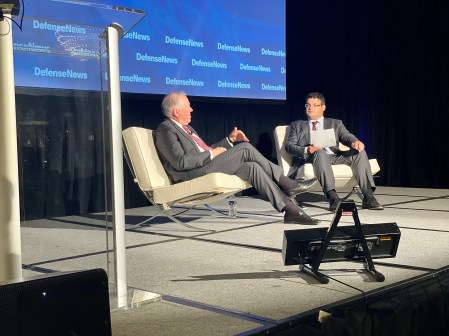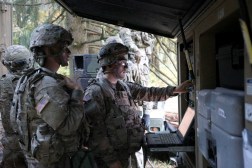How the Army is getting ready for the next Project Convergence tests

To make one of the biggest changes to the use of its networks in decades, the Army is turning to tech to improve its testing.
Project Convergence, the Army’s contribution to Joint All Domain Command and Control (JADC2), is going to get its second major test this November. But before then, it needs to stress-test its tactical network to see if it’s ready to try and achieve interoperability with other services.
To prep for this, the Army has been conducting a range of virtual network tests to ensure that its systems can handle a project centered on increasing the amount of battlefield data used to make decisions.
“As a former signal officer, the last thing you want to find out is your system doesn’t work because of improper grounding or configuration that you could have dealt with in the lab or in some sort of hybrid environment,” said Maj. Kristen Pietrasz, an acquisition officer for the Army’s Command, Control, Communications, Computers, Cyber, Intelligence, Surveillance, Reconnaissance (C5ISR) Center.
JADC2 is the military’s new framework of building a connected battlefield where data from sensors across all domains can give commanders deeper insights into a battle. The Army’s response to the call to connect everything is Project Convergence, which focuses on connecting sensors that will improve targeting speed and accuracy.
In the fall of 2020, the Army assembled a team of coders, senior leaders and others in the desert of Yuma Proving Ground, Ariz., to conduct its first major test event. One of its lessons learned: networks need to be prepped in air-conditioned rooms, not in the dessert in late summer.
To help modernize its tactical network through virtual testing, the Army built the Joint Systems Integration Laboratory (JSIL) at Aberdeen Proving Ground (APG), Md. The JSIL digitally connects Army and other service labs in a virtual environment that the Army says reflects the conditions of JADC2.
“This, in turn, creates efficiency by enabling the services to address network challenges that would otherwise take up precious testing time during PC21,” the Army stated in a release.
The lab hosted two fully virtual tests already and recently conducted its first mixed virtual-live test event dubbed “communications exercises (COMMEX) 2.x.” The new type of mixed test connected to labs run by the Navy, Air Force and Marine Corps as well as “dismounted systems,” or platforms being operated in the air and in field exercises.
“In ten days, we achieved the same results that we would have if we had spent six weeks in the desert,” said Kim Moeltner, chief for the C5ISR Center’s Systems Engineering and Integration Branch.
By connecting with other services, the Army is already working toward achieving one of the major goals of Project Convergence 21 — linking other services to its system. One of the key goals of JADC2 is to achieve interoperability between the services, a milestone that would overcome both technical and cultural hurdles. Future Project Convergence tests will also include experiments involving allied and partnered militaries.
The next two COMMEXs will be more physical than virtual, taking place once again at Yuma Proving Ground to build and test air-to-ground mesh networks, not just the tactical network already in place.
“This has been instrumental because it allowed us to overlay laboratory experiments at the same time we were doing field experiments. We’ve done the laboratory piece, we’ve done the field piece, and this was new for us to be able to layer all three at the same time at speed, at scale and at range,” said Col. Tobin Magsig, commander of the U.S. Army Joint Modernization Command.

This story was featured in FedScoop Special Report: Network Modernization - A FedScoop Special Report






